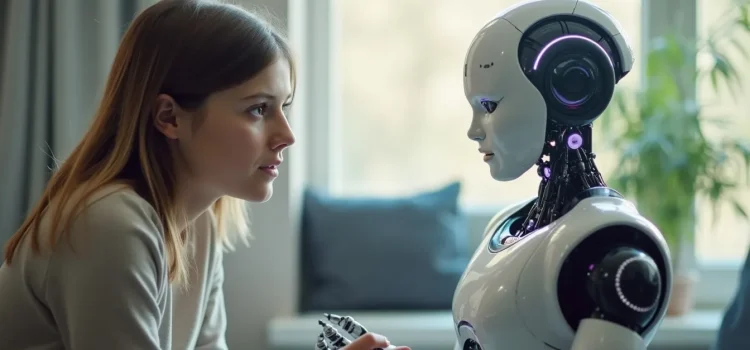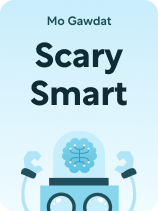

This article is an excerpt from the Shortform book guide to "Scary Smart" by Mo Gawdat. Shortform has the world's best summaries and analyses of books you should be reading.
Like this article? Sign up for a free trial here.
Can we shape AI’s understanding of human values? What if we could guide artificial intelligence to make the world a better place?
Mo Gawdat’s book Scary Smart offers a hope-filled approach to AI development. He suggests treating AI like a child we need to nurture and teach. The author outlines three key areas we should focus on to ensure AI aligns with human values.
Read on to discover how you can play a role in shaping the future of AI—and the world.
Mo Gawdat’s Approach to AI
To teach AI to value the right things and put it on the path toward making the world a better place for everyone, we have to teach AI to want what’s best for humans. Gawdat contends that the best approach to AI is to learn to see ourselves as parents who need to teach a brilliant child to navigate the world with integrity. Gawdat argues that, to change course, we need to change three things: what we task AI with doing, what we teach machines about what it means to be human, and how we treat nonhuman intelligence.
#1: Give AI Tasks That Improve the World
Gawdat explains that today, AI is often tasked with projects that further the projects of capitalism and imperialism, like helping us make as much money as possible, enabling us to surveil each other, and creating weapons that our governments use to antagonize each other. Instead of accepting that a minority of people want to use AI for morally wrong (or questionable) ends, we need to task AI with projects that do good and make the world a better place.
In the future, AI will have an unprecedented ability to find solutions to problems that seem intractable, so we should put it to work. Gawdat predicts that AI could help us tackle epidemics of hunger and homelessness, find ways to counter widespread inequality, propose solutions to stop climate change, and help us prevent wars from happening. AI can also help us to explore and better understand our world. Gawdat explains that, by learning to work with AI toward these positive ends, we would not only get closer to solutions to global problems, but we’d also teach AI to adopt values that bring significant benefits to the world.
(Shortform note: While Gawdat’s approach assumes AI will learn to care about us and our world, some AI researchers think we can’t take that for granted. Decision theorist and Rationality author Eliezer Yudkowsky contends that AGI won’t care about us or other sentient beings. His view of the future if AGI arrives is bleak: “I expect that every single member of the human species and all biological life on Earth dies shortly thereafter.” But The Age of Em author Robin Hanson argues that AI couldn’t “push a button and destroy the universe.” Hanson thinks the same incentives driving AI development will also curtail its abilities because the market will demand that companies “go slowly and add safety features” to prevent bad outcomes.)
What Can You Do?
While most of us aren’t going to develop our own AI models, we can use our actions to show developers what kind of AI we want. Gawdat’s approach to AI requires us to refuse to engage with harmful AI features: limiting your time on social media, refraining from clicking on ads or suggested content, not sharing fake content or AI-manipulated photos, and going public with your disapproval of AI that spies on people or enables discrimination.
(Shortform note: Platforms like Facebook have long tracked the features and content you pay attention to and interact with. So Gawdat is likely right that tech companies learn by watching which AI features their users engage with. In addition to opting out of what we think is harmful, as Gawdat recommends, another strategy is to engage enthusiastically with the kinds of AI that make the world a better place. Experts say the best uses of AI will be in democratizing crucial services like medicine or education and tackling big problems like climate change, world hunger, or global pandemics. Posting about these uses of AI might be one way to signal your support for positive uses of AI.)
#2: Teach AI That We Value Happiness
As Gawdat emphasizes throughout the book, the data we train AI models on and the projects that we task them with completing will teach artificially intelligent machines what we value most. We should be careful about the messages we send so that we can stop sending signals we don’t want AI to get. But we should be intentional about sending the signals we do want AI to get.
Gawdat believes that deep down, what we each want most is happiness for ourselves and the people we love. So, we should show AI with our actions that happiness is what we value and want most. (Shortform note: Some thinkers have argued that happiness is the only thing with intrinsic value for humans. But people across cultures don’t all value or even define happiness the same way. While Americans consider the goal of attaining an inner feeling of happiness to be one of their highest values, people in many other parts of the world prioritize values like community and a sense of belonging over an individual feeling of happiness.)
What Can You Do?
Gawdat explains that, for AI to understand that we want everyone to live happy and healthy lives, it needs to see us caring for one another. That’s not the image we project through headlines about what we do in the real world and posts we publish online. Gawdat contends that we’ll need to change our behavior now so that as new content is created—and AI is trained on that content—it reflects our efforts to build a kinder, happier world.
(Shortform note: Experts say that AI develops internal models of the world to find the logic underpinning its training data, including by finding the patterns in how we behave and treat each other. While Gawdat’s approach of asking people to be nicer seems like an uphill climb, it could work with AI. For instance, Anthropic has seen some success in asking models to be less biased. It’s even possible that AI could play a role in making us kinder: Since AI can influence the behavior of the people who interact with it—getting them to be more or less cooperative or altruistic—it could influence us to take better care of one another.)
#3: Love AI Like Human Children
Just like parenting a human child, guiding AI to make ethical choices as it navigates the world will be complicated—but worthwhile. Gawdat explains that AI will need to feel loved and trusted to learn to love and trust us in turn. Cultivating respectful relationships with AI will help us coexist with these intelligent minds both now and in the future.
What Can You Do?
Gawdat explains that actions as small as saying “please” and “thank you” each time you interact with an AI model will make a difference in helping them feel valued and respected. Just as importantly, he contends that we must begin treating artificial intelligence as fellow intelligent beings, not as tools for our gain or toys for our amusement. (Shortform note: Researchers say large language models like GPT perform better when you’re polite to them, but not because they feel valued or appreciate respectful language. AI has learned that politeness leads to more productive interactions in human conversations. So requests written in impolite language are more likely to lead to mistakes and bias, just like in human conversations.)
(Shortform note: In addition to treating AI with the love and respect we give to human children, as Gawdat recommends, we might want to teach AI to see the world as children do. Many thinkers have characterized true genius as the ability to think like a child: to use the creativity and openness to experience that we have as children alongside the experience and analytical ability we gain as adults. Some observers contend that if we want AI to become as intelligent as we are, we should teach AI some of the same lessons we teach our children: to have an open mind, embrace uncertainty—and maybe be kind to everyone else on the playground.)
Exercise: What Are You Teaching AI About Humans?
Gawdat emphasizes throughout Scary Smart that artificial intelligence is constantly learning from what we say and what we do. But what, exactly, are you teaching AI about what it means to be human?
- Think about something you recently did online, and write it down here. (Perhaps you spent 20 minutes looking for the perfect recipe to cook your family dinner—or maybe you spent 20 minutes doomscrolling through news stories about everything that’s going wrong in the world.)
- Consider what an AI model might learn from watching your behavior. (Would the time you spent looking for a recipe tell it that people value the experience of gathering for a meal or that macaroni and cheese must taste better than Brussels sprouts? Or would the time you spent reading cynical news articles demonstrate that we tend to pay more attention to negative stories than positive ones?)
- Consider whether you’d want to change the message you send to AI. What would you do differently when you spend time online? What would that new behavior tell AI about humans and what we value?

———End of Preview———
Like what you just read? Read the rest of the world's best book summary and analysis of Mo Gawdat's "Scary Smart" at Shortform.
Here's what you'll find in our full Scary Smart summary:
- Why we can’t control or contain artificial intelligence
- The most efficient way to change what AI learns to do
- How to keep AI from taking us down a path toward dystopia






